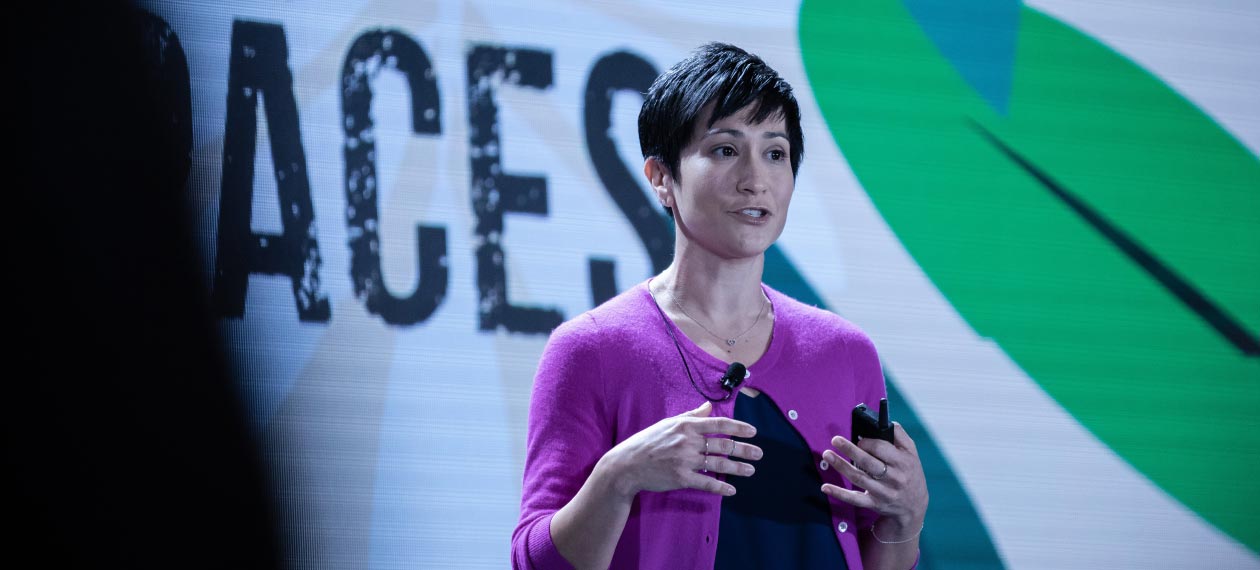Going to work is no longer about sitting at a desk and earning a paycheck. More people entering the workforce today look for opportunities to not only make a difference in the world but also knuckle down on work that enriches their own lives and wellbeing.
So it makes sense that the most successful companies today are doing their best to create work environments that align with the developing values and long-term goals of their employees. But exactly how they can achieve this goal hasn’t always been clear.
That’s where the International WELL Building Institute (IWBI) comes into play. IWBI’s WELL Building Standard provides a framework to intentionally combine design, wellness programming, and policies to achieve workforce health goals and cultivate workspaces where all employees can thrive.
“What WELL is doing is overlaying a scientific approach on top of the drive for amenities and that desire millennials have to be at an organization that aligns with their values and supports them as a whole person,” said Rachel Gutter, president of IWBI.
Gutter recently spoke at WorkSpaces about the WELL Building Standard and its aims to guide workplaces both physically and organizationally into areas that are both good for people and good for a business’ bottom-line.
There's LEED, Then There's WELL
The WELL Building Standard is a performance-based system for measuring, certifying and monitoring features of the built environment that impact human health and wellbeing through a number of concepts.
IWBI created the WELL Building Standard in line with scientific research that explored the connection between the buildings we spend more than 90% of our time in — otherwise known as our workspaces — and the health and wellbeing of those inside.
"While LEED (Leadership in Energy and Environmental Design) certification aims for planetary health, our center of gravity is human health," Gutter said. “WELL is really, at its heart, looking at outcomes to the built environment within organizations that can be transformative for human health and productivity.”
Though IWBI has found many organizations pursue WELL for the purpose of recruitment and retention, other factors, such as improving mental health management and reducing health care costs, also factor into the overall outcome.
“The workforce suffers more today than ever from stress and burnout and those map so directly to a business’ bottom-line,” Gutter said in a sit-down chat following her talk. “What we provide are science-backed strategies that help to address those types of risks.”
A Return to Wellbeing
Gutter noted that WELL has prompted a return to “native intelligence,” or the idea that our environment sustains us.
"At some point we lost the connectivity and the sense of interdependence with our physical environments," she said. "We built these boxes around ourselves to keep all of these things out." And in the process, we've ended up starving ourselves of a lot of the critical nutrients and supports we need to lead our best and healthiest lives."
Reclaiming our environments, especially those where we work, is of critical importance, Gutter said. In fact, Gutter cited research from the Centers for Disease Control and Prevention that has shown our physical and social environments – where we sit and who we sit next to – have a greater impact on health than genetics, lifestyle behaviors and access to medical care combined.
“WELL views buildings and organizations as vehicles of public health,” Gutter said. “We know more and more that organizations like LinkedIn are embracing a culture of health and wellbeing, and they’re finding that the [resulting] impact of this on community and society have a far greater ripple.”
It’s not just a business’ bottom-line, but employees’ lives that are impacted. That’s because, as Gutter put it, “some of the best places to impact behaviors at home, is at work."
WELL is positioned to support organizations to do just that by measuring, verifying and monitoring building and organizational features that impact health and wellbeing of employees.
Achieving WELL
The WELL Building Standard certification process looks at interventions, or point-earning opportunities, across which the building can do through design and operational interventions. It also evaluates that which the organization can do through programs, policies, plans and improved benefits and amenities, Gutter said.
"We've looked at all of the different ways that research has told us that built environment or organizational practices can improve human health and productivity-related outcomes and we've translated those to interventions," Gutter said.
Armed with a team of professionals and experts, IWBI created dynamic scorecards that can be customized for an organization's purpose and intentions.
|
|
"There is an ever-expanding library of interventions," Gutter said. "The scorecard lets organizations map to what they can control and what they can influence."
Organizations can seek point-earning opportunities within 10 concepts related to air quality, water quality, nourishment, light, movement, thermal comfort, sound, materials, mind, and community.
That means an organization focused on a new construction project can choose interventions that lean toward the building process, while an organization with an existing facility might lean toward interventions related to strategies and policies.
“Everybody sees workplace wellness through a different lens,” Gutter said. For instance, in Asia – IWBI’s largest market – there’s an acute awareness of the importance of indoor air quality, while organizations in Australia tend to focus on adding wellness opportunities to their amenities.
Gutter noted that as part of the WELL-certification process, IWBI uses a performance verification system.
"Every project that becomes WELL-certified is visited by a third-party testing agent that tests the elements and performs a series of spot-checks," she said.“Everybody sees workplace wellness through a different lens,”."This helps you to have confidence the things you were intending to do on the project were achieved."
Gutter added that no well-intentioned customer has failed to achieve WELL-certification. Though, some have to re-evaluate areas.
For instance, she recalled a developer that had failed the air quaintly test twice. The company was finally able to trace the issue to pistons in an elevator shaft — a flaw they would never have stumbled upon without undertaking evaluation for certification.
Success Stories
Overall, IWBI found that property owners have reported overall satisfaction with the WELL certification system and its outcomes for both organizations and employees.
Gutter said that 73% of property owners found a positive impact on their building lease rate after certification, while 79% said there was a positive impact on occupant satisfaction following the process. When two members of the IWBI standard development team traveled to Mexico City during the company's remote pilot program, they visited a future WELL-certified building. Though the building isn't finished, the developer noted that it was already 60% leased, while comparable buildings in the area were only 10% leased.
Gutter also provided several examples of organizations that found employee wellbeing had increased after WELL-certification. A Canadian organization found that after establishing WELL-certified offices employee turnover rate decreased by nearly a third, while the hiring of new talent had doubled. Another company in London realized a savings of £200,000 annually due to a reduction in employee sick days.
The Next Steps
IWBI recently signed on to the United Nations' Sustainable Development Goals initiative that aims to create a blueprint to achieve a better and more sustainable future.
"One of the first exercises we did was map WELL features to the Sustainable Development Goals and subgoals," Gutter said. "There was 100% alignment."
IWBI found that organizations aiming to make advancements in their Sustainable Development Goals, particularly those working with low-income communities and developing countries, could actually leverage WELL as a framework. "This has taken us on a real journey to discovering the value proposition of a program that was already in development, called WELL Portfolio," Gutter added. WELL Portfolio, currently in a pilot phase, was designed to be applied to all of an organization's assets and acknowledge and reward the organization for its achievements.
"We found that we created a new framework that doesn't assume that certification is the aspiration, that honors the journey even more than the destination," Gutter said. "That can be leveraged for much higher purposes within the organization."

Posted by
Join us at WorkSpaces!
The retreat for corporate real estate and workplace innovators.
Oct 4-6, 2026 | Santa Barbara, CA





-3.png)
-3.png)


-2.png)

Comments